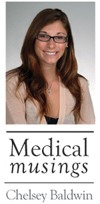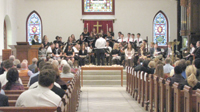|
Editor's Note:
Chelsey Baldwin of Little River is a first-year medical student. This
column follows the journey of her class in becoming doctors.
 Behind the doors of the sixth floor
human anatomy laboratory in the Basic Science Building, I have
experienced sights and conversations that I don't believe I'll ever
forget. Behind the doors of the sixth floor
human anatomy laboratory in the Basic Science Building, I have
experienced sights and conversations that I don't believe I'll ever
forget.
I've held every organ of
the human body. I've witnessed the aftereffects of aneurysms and muscle
wasting. I've also followed major nerves and vessels as they course
through obscure foramens and canals, and have seen abnormalities of
structures caused by disease processes. There is a plethora of material
to learn in the human dissection laboratory, both medical and social.
Spending several hours in lab each week, I have designated time for
social interaction.
Throughout the course of
our time spent together, I've come to learn that the clearing of fat is
best accompanied by gossip. Long dissections double as much needed
social time and "that's what she said" jokes never get old. Yet beyond
the social pleasantries of lab, I have grown accustomed to the patterns
of the human body through debates of nerve and vessel pathways and
memory tricks (the more vulgar, the more memorable), and most
importantly through the exploration of our cadavers.
I remember hoping that my
cadaver would be a male. My reasoning—it would be less personal.
Despite the fact that I got my wish, there is nothing about human
dissection that isn't personal. Attempting to detach oneself from the
reality that the specimen was a human being is a defense mechanism that
is only temporarily necessary. However, acknowledging that my cadaver
used to be a person and possessed all the details of life that make us
human added depth to the experience.
And as a person, he needed
a name. We began calling our cadaver Ebenezer, Ebby for short, for he
was an elderly man with a hunched back, and we found the name fitting.
Having examined his wasting muscles and various structural
abnormalities, I constructed segmented pieces of his life, rarely
taking the time to acknowledge that these beliefs about his personality
and life story were of my own doing. Throughout the year I had grown
attached to this body not only because of the minor bits of personality
that I had concocted, but also because his body had provided the most
unique learning experience that I had ever had.
I often translated the
beauty of the structures into a masterpiece that was a product of my
group's dedicated hours of work and Ebenezer's own desire to give us
something great. And that he did. The donation of his body is truly the
most generous gift that I have ever been given. It's a gift of such
importance that seems to require a follow-up or repayment.
Yet how could I repay this
debt? The answer fell quite uncomfortably in my lap in the latest
installment of medical history given in a lecture in the Waring
Historical Library. One of my favorite lecturers, Dr. Stephen Schabel,
was discussing the staples of medical education—one of which he
believed to be cadaveric dissection. Dr. Schabel viewed dissection as a
crucial part of our education as physicians, however upon accepting
such an educational opportunity, it is now a debt that we all must
repay. Since we know nothing of our cadaver's life or family, this debt
cannot even be paid back to them indirectly.
Instead, Dr. Schabel led
us to his conclusion, that it's our bodies that we owe to future
physicians. We must complete the cycle: from the scalpel to the
table—the thought of which is often hard to embrace. I feel like it
should be easier to commit my body to the dissection lab after
experiencing the educational benefits of human dissection. I believe
that Dr. Schabel's reasoning makes sense, and it is my opportunity to
give future physicians an opportunity to learn the intricacies of the
human body just as Ebenezer did for me. However, ironically enough when
speaking of death, the fear of the known can be a quite terrifying
place as well.
 The MUSC Choir performs March 28 at
a
remembrance service held at St. Luke's Chapel to honor donors to the
Anatomical Gift Program. Students shared music and their reflections to
honor the donors and their families for their part in the advancement
of medical science. The MUSC Choir performs March 28 at
a
remembrance service held at St. Luke's Chapel to honor donors to the
Anatomical Gift Program. Students shared music and their reflections to
honor the donors and their families for their part in the advancement
of medical science.
I hope that my hesitancy
is a product of my age, and therefore my inability commit to a
postmortem plan may be forgiven. For now through, I thank Ebenezer as
best I know how: Our group's dissections are always done with care and
tend to be a product we take much pride in. I feel like getting the
most out of each dissection is a way to acknowledge and show
appreciation for the magnitude of the gift we have received. I also
plan to be an advocate for maintaining cadaveric dissection in medical
curriculum. With rumors of change towards a computerized experience, I
feel that this is a movement I must oppose. While it is true that
digital specimens can augment anatomical learning, I don't wish to
discount Ebenezer's gift in such a way as to insinuate that a computer
screen can come close to replacing the experience his body afforded me.
Human dissection is a part of a long tradition of those concerned with
the healing of the human body and one in which I feel strongly about
maintaining for future generations of doctors.
I attended the Anatomical
Gift Program's memorial service and there among the poems and swirling
notes of my musically-gifted peers, I thanked Ebenezer. I remembered
all the beliefs that I had about him and then resolved that the only
thing that I can be sure of was that Ebenezer was a generous man who
had the courage to see past the immediate unpleasantries of dissection
to the beauty of the knowledge which he has bestowed upon me.
For that I will always be thankful.
|



 Behind the doors of the sixth floor
human anatomy laboratory in the Basic Science Building, I have
experienced sights and conversations that I don't believe I'll ever
forget.
Behind the doors of the sixth floor
human anatomy laboratory in the Basic Science Building, I have
experienced sights and conversations that I don't believe I'll ever
forget. The MUSC Choir performs March 28 at
a
remembrance service held at St. Luke's Chapel to honor donors to the
Anatomical Gift Program. Students shared music and their reflections to
honor the donors and their families for their part in the advancement
of medical science.
The MUSC Choir performs March 28 at
a
remembrance service held at St. Luke's Chapel to honor donors to the
Anatomical Gift Program. Students shared music and their reflections to
honor the donors and their families for their part in the advancement
of medical science.